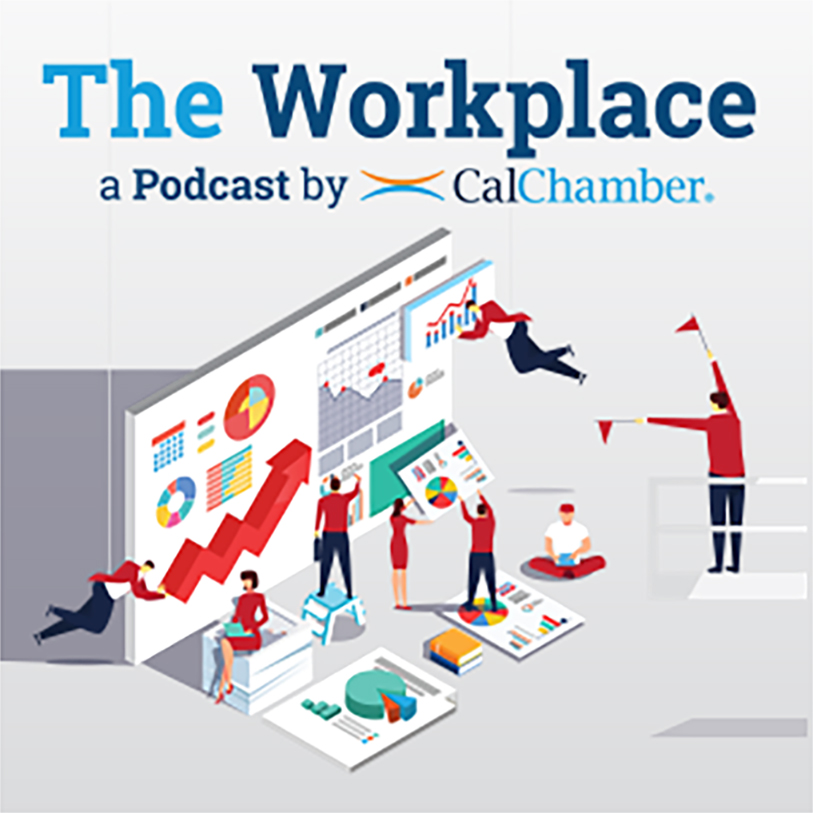In this episode of The Workplace podcast, CalChamber employment law expert Matthew Roberts and Global Head of Occupier Thought Leadership at CBRE Group, Inc. Julie Whelan discuss current employer attitudes toward in-person work and returning remote workers to the workplace.
We are now nearly 30 months removed from the start of the COVID-19 pandemic, and out of the whirlwind of workplace trends and changes, the most enduring change we will see moving forward is where employees are going to be performing their work, Roberts says in kicking off the podcast.
“Remote or hybrid work arrangements are now the norm instead of the exception,” he says. “As we enter a relative period of stability with COVID-19, employers are now at that stage of deciding whether to end remote hybrid arrangements and what to do with the commercial real estate and workspaces they had pre-pandemic.”
In April, CBRE released findings from its latest annual survey on office occupier sentiment, revealing trends in executive attitudes toward returning employees to the workplace in 2022. CBRE, a CalChamber member, has been conducting this wide-ranging survey on office occupier trends since 2016.
April 2022 Survey Results
CBRE’s April survey confirmed what everyone had been feeling in the market at that point, which was that office returns were slowly happening, Whelan says. Efforts were slow because employers were allowing workers to return at their own discretion, and organizations were not influencing employees to come back. Returns also have been slow now because it’s summertime.
The survey also indicates that hybrid work is here to stay. Organizations are supporting the hybrid work evolution and, most importantly, executive leadership is acknowledging and supporting this evolution as well, Whelan says.
Another survey finding is that the office is not an afterthought. The office is still a very important piece of company culture for most companies. Organizations are starting to make moves in their real estate strategies to satisfy changes, such as new space design, enhancing technology, tracking utilization, looking for different spaces, lease catalysts and activities.
Asking Workers to Return to the Office
The 2022 survey did not ask employers what type of reasons they used to justify asking their workers to return to the office. Based on past surveys, employers consistently said they wanted people to work in the office to build culture, and promote collaboration, knowledge sharing and innovation. The problem, Whelan points out, is that these are generic statements at this point in the journey.
“What we’re finding right now is that most companies are really trying to take time to understand what those words mean to them, and then spending time translating that to employees in a way that actually creates an appealing value proposition for employees to come back to the office,” she says.
Facilitating Office Returns
In the beginning, employers enticed workers to return to the office using things like events and welcome packages, but this changed when the Omicron variant emerged. Employers came to the realization that these events were time consuming, expensive and were not going to create anything sustainable, Whelan tells Roberts.
What organizations are doing now is communicating through memos, videos and other mediums why the company wants employees back in the office. Many organizations also are asking executive leadership and managers to lead by example, because if the executives and leaders are not coming in themselves, then certainly the lower ranks of the organization aren’t going to feel compelled to do so, Whelan points out.
Lastly, organizations are starting to create offices that people want to be in now. How happy employees are at the office is going to dictate how often they want to come back. The pre-pandemic office environment also is a factor.
“If it was a really bad office environment then, it’s going to be an even worse office environment now. And so, we really need to make changes to make sure that our employees are happy when they come in,” she says.
Hybrid Work Sweet Spot
Generally, employers want their employees to be in the office at least half the time, if not more. What the latest CBRE survey found, however, is that a lot of companies are realizing that there’s a gap between what they desire as an organization and what their employees desire as people, Whelan says. In order to close that gap, many employers are realizing that it’s going to have to be more of an equal mix.
Providing guidance to jump-start getting people to come into the office more regularly than they do now while still allowing employees to have the sense of autonomy that is important to them is a piece of the equation that employers still are struggling to figure out, she says.
Redesigning Office Space
Organizations have known that they needed to change their space design principles for a long time, but there wasn’t a huge catalyst of activity to make them change it, Whelan says. Now, behaviors have changed rapidly because of the pandemic and they’re not going back.
If companies continue to operate space like they used to, it’s going to be grossly inefficient and the space is not going to be heavily utilized, she explains. Employers are realizing that if people are only going to come in on a part-time basis, and if they assign people to desks and cubicles like they used to, it’s not going to work anymore.
What Whelan is seeing first and foremost is space sharing, even within current footprint, layout and design.
“We’re going to have people share their space, because it is just more efficient to do it that way, which leads to a whole lot of policies around clean desk policies, and how do you know if they’re in use or not,” she says.
Additionally, space design is changing toward spaces where people have more command over their space. Instead of being assigned a specific desk, employees can walk into a shared environment and go into any number of locations that may work for them on that particular day. This gives people optionality in how they work.
This set up also allows for more collaboration. Employees coming into the office want to do less “me work” and more “we work.”
‘Business Is Run by People’
Whelan says that the biggest takeaway from CBRE’s survey is that companies are realizing that their business is run by people. Employers are focusing on how their workers are impacting their business, but they also are focusing on how their business, culture and policies are impacting those workers in turn.
It’s a two-way street.
“If you look at the thread of every answer in the survey and every major response in the survey, it was always based on people and what they need to be happy in their space to be productive in their work life and to do ultimately the best for the organization that they work for,” she says.
CalChamber members can read more about How to Ensure a Successful Hybrid Work Environment on HRCalifornia. Not a member? See how CalChamber can help you.







